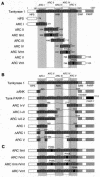Functional subdomain in the ankyrin domain of tankyrase 1 required for poly(ADP-ribosyl)ation of TRF1 and telomere elongation
- PMID: 14966275
- PMCID: PMC350561
- DOI: 10.1128/MCB.24.5.1944-1955.2004
Functional subdomain in the ankyrin domain of tankyrase 1 required for poly(ADP-ribosyl)ation of TRF1 and telomere elongation
Abstract
In human cells, telomere elongation by telomerase is repressed in cis by the telomeric protein TRF1. Tankyrase 1 binds TRF1 via its ankyrin domain and poly(ADP-ribosyl)ates it. Overexpression of tankyrase 1 in telomerase-positive cells releases TRF1 from telomeres, resulting in telomere elongation. The tankyrase 1 ankyrin domain is classified into five conserved subdomains, ARCs (ankyrin repeat clusters) I to V. Here, we investigated the biological significance of the ARCs. First, each ARC worked as an independent binding site for TRF1. Second, ARCs II to V recognized the N-terminal acidic domain of TRF1 whereas ARC I bound a discrete site between the homodimerization and the Myb-like domains of TRF1. Inactivation of TRF1 binding in the C-terminal ARC, ARC V, either by deletion or point mutation, significantly reduced the ability of tankyrase 1 to poly(ADP-ribosyl)ate TRF1, release TRF1 from telomeres, and elongate telomeres. In contrast, other ARCs, ARC II and/or IV, inactivated by point mutations still retained the biological function of tankyrase 1. On the other hand, ARC V per se was not sufficient for telomere elongation, suggesting a structural role for multiple ARCs. This work provides evidence that specific ARC-TRF1 interactions play roles in the essential catalytic function of tankyrase 1.
Figures








References
-
- Blackburn, E. H. 2001. Switching and signaling at the telomere. Cell 106:661-673. - PubMed
-
- Blasco, M. A., H.-W. Lee, M. P. Hande, E. Samper, P. M. Lansdorp, R. A. DePinho, and C. W. Greider. 1997. Telomere shortening and tumor formation by mouse cells lacking telomerase RNA. Cell 91:25-34. - PubMed
-
- Bodnar, A. G., M. Ouellette, M. Frolkis, S. E. Holt, C.-P. Chiu, G. B. Morin, C. B. Harley, J. W. Shay, S. Lichtsteiner, and W. E. Wright. 1998. Extension of life-span by introduction of telomerase into normal human cells. Science 279:349-352. - PubMed
Publication types
MeSH terms
Substances
LinkOut - more resources
Full Text Sources
Research Materials
